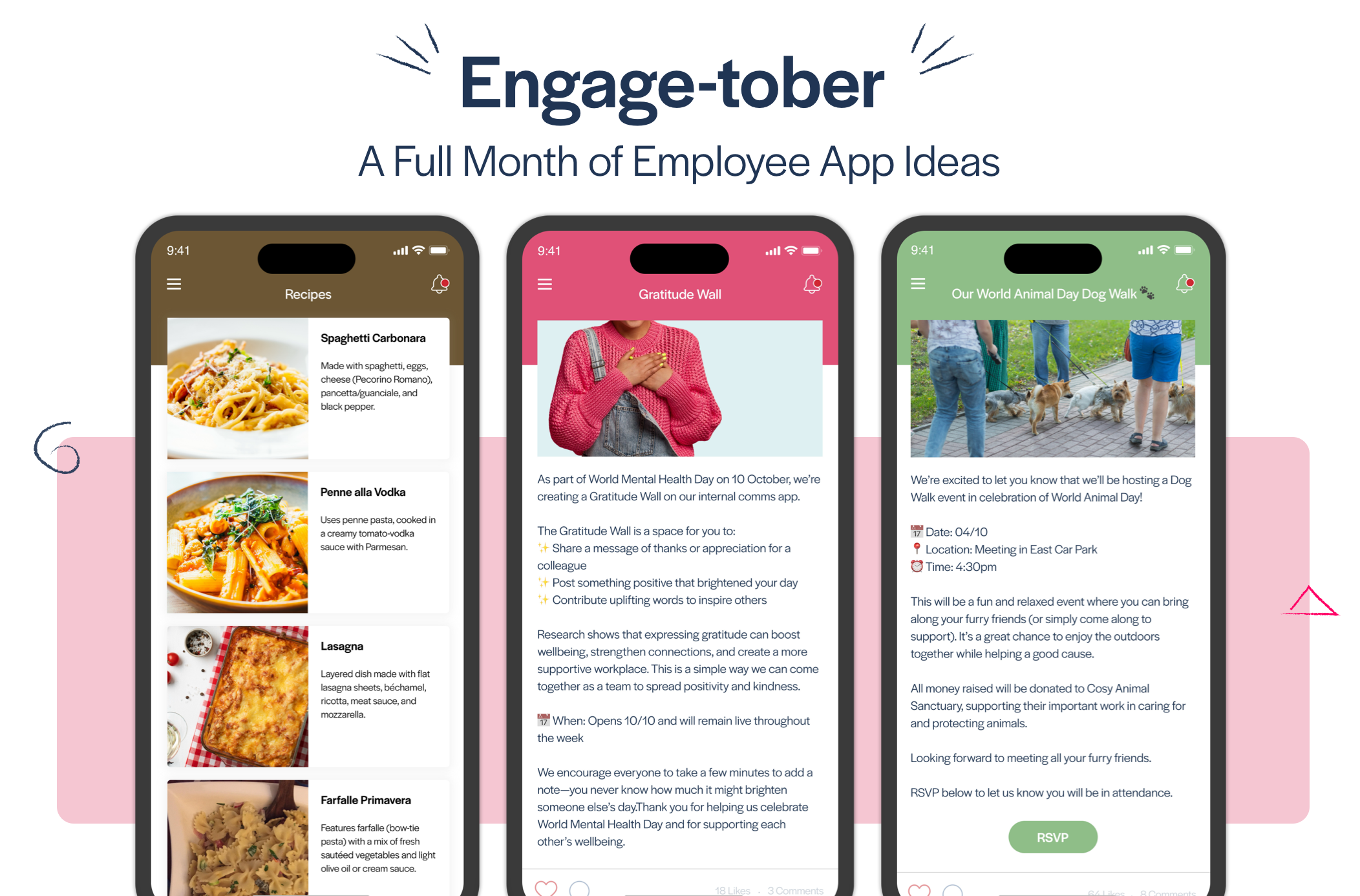
Blog
How to Use an Employee App for Internal Communication
Internal communication is essential to an organisation’s success. Here's how it can benefit your business, and how an employee app can be used to deliver your strategy.

Internal communications today look very different to how they did even just a few short years ago. Thanks to the impact of a global pandemic, a shift towards hybrid working, and a Great Resignation, to name a few, workforces have changed dramatically. And internal communications have had to change with them.
Gone are the days when company communications looked like printed quarterly newsletters, posters on a corkboard, and payslips and forms left on an employee’s desk. Findings from the Global State of Internal Communications 2023 revealed that hybrid workplaces were the most common workplace structure in 2023, and 58% of respondents had deskless employees at their company.
With employees scattered across the globe and working from home or remotely the “new norm”, internal communicators have faced a lot of challenges in figuring out new ways to reach and connect employees everywhere. But what exactly is internal communication? And why should it matter to your organisation?

What is internal communication?
First, it’s worth understanding that although the terms ‘internal communication’ (singular) and ‘internal communications’ (plural) are often used interchangeably, there is a difference between the two.
Internal communication is a critical function of any organisation. At its core, it is the process of informing, engaging, and connecting employees, to the organisation and to each other. It keeps employees up to date on company news, facilitates clear communications between teams, departments and sites, and opens up a two-way dialogue between management and employees.
While internal communication is the overarching view of how an organisation communicates with their employees, the plural internal communications are the tools, tactics and channels used to facilitate this communication, such as intranets, emails, and company newsletters.

Why is internal communication important?
Done right and done well, internal communication does so much more than simply communicate updates across the organisation. It also:
- helps employees to understand and align with the vision and goals of the organisation.
- motivates employees to improve their performance and productivity with clear communication and task clarity.
- gives employees the information and resources needed to do their jobs well.
- brings together scattered or dispersed teams, no matter where they’re working from.
- serves as a platform on which employees can share valuable insights and information, giving them a voice in their organisation.
- enables effective two-way interaction for employees to raise any concerns or issues that the business can address and use to improve upon.
While the primary purpose of internal communication has always been to communicate company goals and strategy, the growing importance of building a strong workplace culture and creating a sense of belonging has also become much more prevalent. According to Gallagher’s State of the Sector 2022/23 report, 74% of respondents feel the purpose of internal communication is to support culture and belonging.
The role of internal communication has therefore had to evolve to navigate a much more complex landscape, one that includes supporting employee engagement and well-being, the employee experience, and improving company culture. Indeed, according to the Global State of Internal Communications 2023 Survey, higher employee satisfaction was one of the key priorities for internal communicators in 2023, while one of the top IC trends was the employee experience.

How an employee app can help
Good internal communication creates a connected workforce, boosts employee engagement, and nurtures company culture – all even more essential than ever in an era of deskless, dispersed and disconnected working.
At Thrive.App, in our initial conversations with clients we often hear the same common internal communication challenges mentioned.
- Employees can often be hard to reach or time poor, and unable to keep up with internal news and updates.
- Employees don’t feel content is relevant to them or engaging enough. For example, they may be receiving information for other departments or teams.
- The teams and individuals responsible for internal communications (often HR and Comms) don’t know what content to create as they don’t know what is working or well received.
- They don’t have enough time or resource to look into this and develop a more appropriate internal communications strategy.
The list of challenges goes on. This is where a platform like an employee app can be an invaluable tool for delivering an internal communications strategy and creating meaningful change within an organisation, as many of our Thrive clients can attest to.

Derry Group Ireland
Derry Group Ireland has always been emphatic in its commitment to employee connectivity and well-being in the workplace. Their Thrive employee app has enabled them to engage with and support their dispersed workforce, keeping everyone informed in real time of updates across all areas of the business. The app has also helped to create a more connected culture and boost their engagement, using recognition to appreciate and celebrate employee successes, and competitions for some light-hearted fun.
Fiona Derry, Derry Group Ireland’s Director of Legal, Compliance and HR, said:
“From a management perspective, at a board meeting the data is there – time has been saved, unnecessary paper trails are gone, and we can see the returns in terms of employee engagement and retention. It has given our staff the confidence to approach us with new ideas, and we know as a company that new ideas means this company is going to continue to grow.”
Biffa
Biffa’s workforce is made up of over 10,000 employees, spread across multiple divisions and facilities in the UK. Most employees are deskless and without a company email address, so Biffa used their Thrive employee app, ‘Biffa Beat’ to transform their communications strategy. The app enabled them to connect and communicate with everyone, no matter where they were, providing them with key company updates and encouraging team engagement.
Helen Hawkins, Head of Communications at Biffa, said:
"Biffa Beat was absolutely essential to us throughout the Coronavirus pandemic. Being able to quickly post updates with dynamic information was a real game changer for us, and the two-way communication of Beat has enabled us to hear our employees’ concerns and questions and address them quickly and efficiently. We love having the ability to send push notifications out to the team to highlight and celebrate some of our key news, all the while knowing that we’re able to reach everyone with our updates so that no-one is left in the dark.”
Want to learn more?
Creating an internal communications strategy can be quicker and easier than you might think, and with a tool like an employee app, delivering your communications can be just easy.
If transforming your internal communication is on your company’s agenda, we’d love to chat about how we can help. Contact us to find out more about how a Thrive employee app can be used as part of your internal comms strategy.









